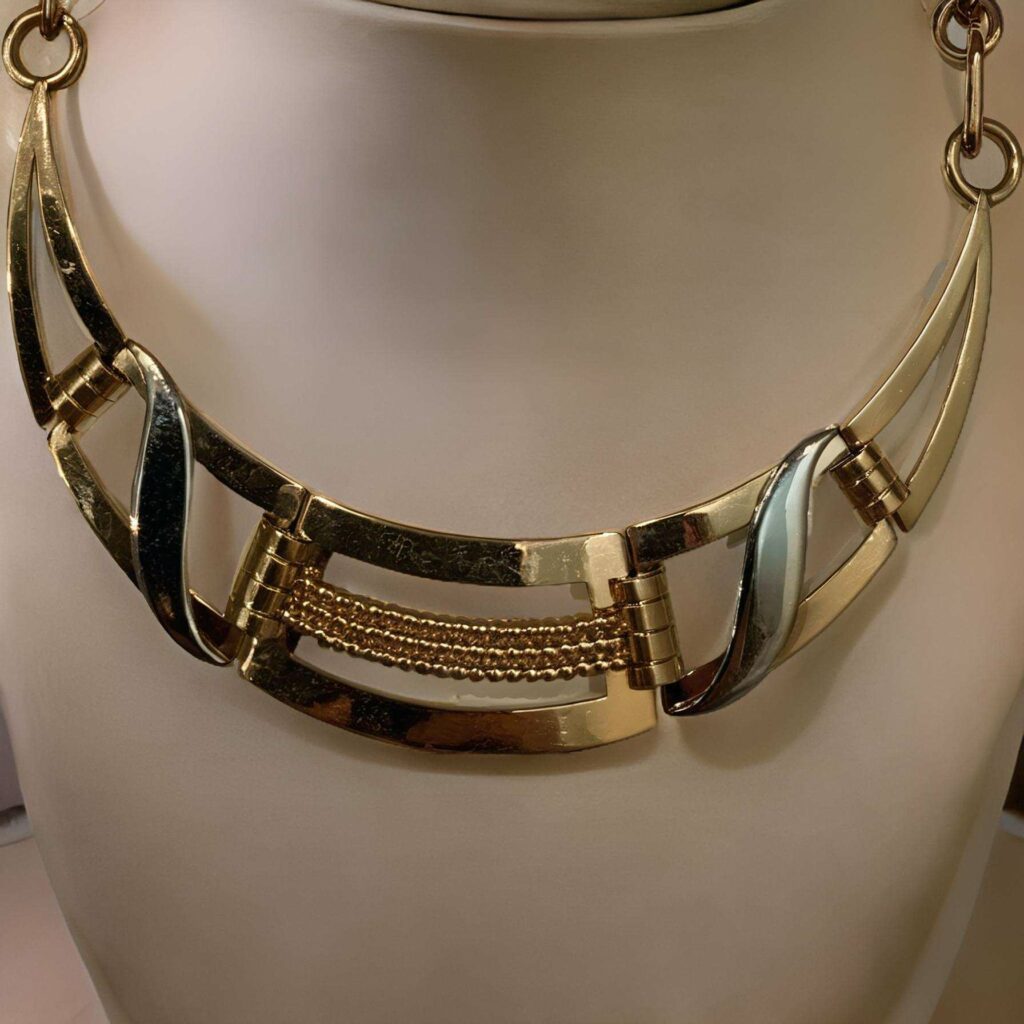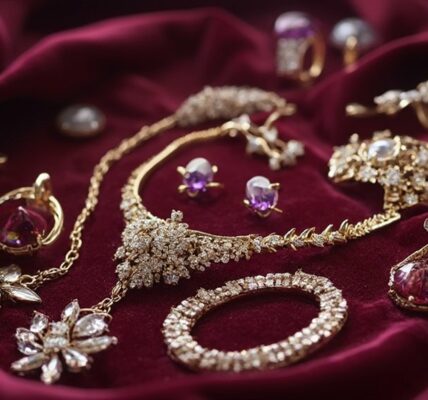Iconic Jewellery Designers of the 20th Century: Jean Després – Machine-Age Aesthetics in Jewellery
Jean Després, often hailed as a master of Machine-Age aesthetics, revolutionised 20th-century jewellery design with his unique approach. His creations, marked by the fusion of industrial elements with fine craftsmanship, showcased bold geometric forms and non-traditional materials, setting him apart from his contemporaries.
Drawing inspiration from his aviation background, Després introduced unconventional motifs like gears and pistons into his work, challenging traditional ideas of luxury. As the Art Deco movement flourished, so did his reputation, prompting a deeper look into how his groundbreaking designs continue to influence modern jewellery artists and collectors alike. Will his legacy remain untarnished?
Article Contents
Early Life and Career
Jean Després, born in 1889 in Souvigny, France, began his journey into the world of jewellery through an apprenticeship as a goldsmith in Paris. This early experience laid the foundation for a career that would intertwine traditional craftsmanship with pioneering design.
Després hailed from a family that valued artistry and skill, which clearly influenced his decision to pursue an apprenticeship. In the bustling heart of Paris, he honed his skills, mastering techniques that would later become the hallmark of his distinctive style. His exposure to the industrial and technological advancements of the time further influenced his approach to design, leading him to incorporate industrial-inspired motifs into his work.
Després’s apprenticeship wasn’t just a technical education; it was a crucible of creativity that shaped his artistic vision. Immersed in an environment rich with cultural and artistic ferment, he developed a keen interest in the avant-garde. During the First World War, Després worked in aircraft engine design, which further refined his mechanical skills and influenced his later jewellery designs.
His friendships with prominent artists like Georges Braque and Jean Dunand further expanded his horizons, exposing him to the radical ideas of Cubism and Fauvism. These influences, combined with his early love for metalworking and mechanics, set the stage for his later work.
His apprenticeship experiences in Paris were more than just a stepping stone; they were the crucible in which his unique artistic identity was forged, blending tradition with bold modernity.
Distinctive Design Traits
Drawing inspiration from the Machine Age, Jean Després revolutionised jewellery design by incorporating industrial elements such as gears, pistons, and mechanical components into his work. His creations were a bold departure from traditional jewellery, embracing textural contrasts and material ingenuity. Després’ signature approach involved using hammered surfaces and enamel work to craft pieces that were both visually striking and tactilely engaging. His preference for metal, particularly silver, over precious stones reflects a material focus that was both groundbreaking and liberating for the time.
Informed by his past work of producing aircraft parts during WWI, Després infused his designs with a distinct industrial aesthetic that set his work apart. Després’ jewellery often featured geometric silhouettes, a nod to the Cubist influence that shaped his aesthetic vision. The blocky, industrial-inspired shapes, combined with distinctive link chains, offered a new form of chic that resonated with those seeking freedom from conventional design.
His collections, such as Bijoux Moteurs, highlighted mechanical motifs, transforming ordinary components into extraordinary adornments. The bold integration of semi-precious stones like coral and lapis added vibrant colour and further improved the textural contrast in his pieces. Each handcrafted item showcased exceptional craftsmanship, blending the domains of art and industry in a harmonious dance that continues to captivate admirers today.
Després’ innovative approach to jewellery design earned him the nickname the “Picasso of jewellery”, reflecting the artistic and conceptual innovation that defined his career.
Influences and Inspirations
During the early 20th century, Jean Després‘ jewellery designs drew heavily from his background in aviation and the industrial sector. His work on aircraft engine design during World War I infused his creations with a distinct mechanical essence. Després adopted industrial motifs, incorporating gears, pistons, and mechanical components into his jewellery, crafting pieces that resonated with the machine-age aesthetic.
This industrial influence was complemented by his affinity for Cubist reductivism, a style marked by geometric shapes and minimalism. His innovative approach to jewellery design led to his works being showcased at prominent institutions, such as the Musée d’Art Moderne de la Ville de Paris, which underscores his significance in the world of art.
Després’ artistry was further shaped by his friendships with avant-garde artists like Georges Braque, whose Cubist leanings informed Després’ own pursuit of geometric purity. He often used unconventional materials, such as silver and hardstones, which were more aligned with industrial applications than traditional jewellery. This choice echoed the Art Moderne and Bauhaus movements, both of which celebrated simplicity and industrial materials. The Second Industrial Revolution, which occurred from about 1870 to 1914, set the stage for such artistic explorations, enhancing the appeal of industrial design elements in jewellery.
Culturally, Després’ work aligned with the modernist movement, characterised by clean lines and symmetrical patterns. His designs paralleled the Steampunk aesthetic, which romanticised 19th-century industrial technology. Therefore, Després stood at the forefront of a period that adopted industrial innovation and artistic exploration.
Famous Creations and Patrons
The unique blend of industrial motifs and modernist ideals in Després’ jewellery caught the attention of prestigious collectors and patrons. His illustrious creations like the Silver and Onyx Necklace, prominently displayed at Palais Galliera, exemplify a mastery of elegance intertwined with the machine-age ethos. Jean Després was nominated President of the Goldsmith Syndicate, and received the Légion d’honneur in 1938, reflecting his esteemed position in the jewellery community.
During the 1930s, Després reached full mastery of his art, developing avant-garde pieces that emphasised harmony and purity of line. Després’ “Bijoux-Moteurs” Silver Deco Brooch, a standout piece from his engine jewellery collection, highlights how collector demand spurred interest in bold, futuristic designs, echoing market trends that celebrated innovation in the 20th century.
Després’ versatility is evident in the 18K Gold Aquarius Zodiac Signet Ring, crafted in the 1950s, and a 1940 Lapis Lazuli and Gold Ring, combining precious and semi-precious stones to create sophisticated expression and intricate artistry. The hand-hammered Silver Bracelet showcases his technique, producing alluring textural contrasts.
His association with esteemed galleries such as Macklowe further cements his legacy, ensuring that his creations continue to infiltrate museum collections worldwide, maintaining their allure. As art enthusiasts and collectors gravitate towards modernist jewellery, Després’ work remains en vogue, influencing and inspiring a generation keen for liberation from traditional norms, reflecting an enduring appeal that defies conformity.

Art Deco and Machine Age Influence
Jean Després’s work epitomises the Art Deco movement‘s fascination with geometric shapes and symmetry, creatively integrating industrial materials like Bakelite and orleum into high fashion jewellery. His pieces reflect the technological advancements of the Machine Period, utilising techniques that adopted both precision and innovation to expand the boundaries of jewellery design. Art Deco jewellery, initially catering to the upper classes, soon gained popularity among the middle class, showcasing the era’s blend of everyday function and decor. The discovery of King Tutankhamun’s tomb in 1922 also played a significant role in inspiring the ancient motifs and designs that became integral to the Art Deco aesthetic.
Geometric Shapes and Symmetry
Multiple design movements converged in the early 20th century to shape the aesthetic of Jean Després’ jewellery. His creations epitomise geometric elegance and symmetrical harmony, hallmarks of the Art Deco movement.
The period was marked by strong, clean lines and geometric shapes, reflecting the zeitgeist’s affinity for innovation and modernity. Després accepted these principles, incorporating rectangles, squares, and chevrons into his pieces, echoing the streamlined silhouettes of skyscrapers and automobiles. In the 1920s and 1930s, his jewellery captured the spirit of Art Deco, blending architectural influences with design precision.
His adept manipulation of platinum settings contrasted with bold gemstones such as onyx and coral, creating enduring visual impact. Notably, many of his pieces exhibited kinetic elements, a characteristic that defined his modernist and machine-inspired approach.
While Art Deco set the stage, Machine Age aesthetics enhanced Després’ artistry. His involvement with aircraft engine design during the First World War left an indelible mark on his creations.
Influenced by mechanical components, his jewellery mirrors the rugged yet refined attributes of machinery. Crisp lines and symmetrical patterns defined his work, harmonising the stark elegance of industrial design with luxury.
Després’ avant-garde pieces resonated with individuals yearning to break free from tradition, offering a fresh, liberated perspective on luxury jewellery. Each piece is both a product of its time and a confirmation of the visionary mind behind it, exuding freedom through form and symmetry.
Industrial Materials in Design
Something transformative happened in jewellery design during the Art Deco and Machine Age periods with the incorporation of industrial materials. As the world adopted industrial innovations, jewellery designers began experimenting with materials that broke from traditional forms. In this context, the geometric shapes characteristic of Art Deco became a vital element, emphasising the connection between art and industrial progress.
Platinum became the hallmark of strength and elegance, favoured for its malleability and high lustre. Meanwhile, the opulence of diamonds met the stark modernity of these industrial creations, forming a new aesthetic that bridged elegance with engineering marvels. Until the 1930s, diamond became a prominent gem that symbolised high social ranking across Europe.
Jean Després, a pioneer in this movement, masterfully utilised industrial components like gears and mechanical parts in his designs, pushing the boundaries of material experimentation. His designs often featured bold, geometric silhouettes that echoed the structured resilience of the Machine Age.
Pieces from his “Bijoux Moteurs” line embodied elements reminiscent of rods, cog-wheels, and gears, bearing testimony to his stint in the aviation industry during World War I.
During the economic hardships of the Depression, jewels crafted from metal alloys and imitation stones made luxury accessible to a broader audience, signalling a shift in the jewellery market. Després’ legacy is a reminder of the unyielding spirit to innovate that characterised the Machine Age, forever transforming jewellery design.
Technological Advancements’ Influence
Building on the momentum of industrial materials in design, the influence of technological advancements during the Art Deco and Machine Age periods became a defining force in jewellery design. Jean Després, a visionary in this evolution, seamlessly integrated technological elements into his creations.
By incorporating motifs resembling rods, cog-wheels, and gears, Després’ jewellery pieces echoed the industrial era’s mechanical elegance. The elegant symmetry and geometry popularised during this era are also evident in the stylistic choices of Després, showcasing his affinity for symmetrical designs. His inventive use of materials further augmented this technological integration, as platinum gained prominence for its durability and flexibility, allowing for more intricate designs. During this period, art deco works were known for their symmetrical and geometrical features, which were visually pleasing and represented a significant cultural shift post-World War I.
Delving into the heart of modernist aesthetics, Després adopted bold geometric shapes and symmetrical patterns. His “Bijoux Moteurs” line exemplified this blend of artistry and engineering, featuring engine-inspired designs. The introduction of materials like black onyx and enamels provided dramatic contrasts amid traditional diamonds, reflecting a preference for material innovation.
As Art Deco evolved, Després’ influence became vital in shifting the jewellery narrative from delicate Art Nouveau femininity to robust, cubism-inspired structures. This shift wasn’t just stylistic; it marked a resurgence in creativity, personifying freedom through art’s bold lines and new horizons, forever altering jewellery’s design lexicon.
Enduring Legacy and Influence
Frequently regarded as a pioneer of modernist jewellery, Jean Després’ enduring legacy lies in his ability to seamlessly blend industrial elements with artistic elegance. His early life experiences in Avallon at his parents’ jewellery shop, coupled with his apprenticeship and education in Paris, helped shape his design style and approach. The design evolution in his work mirrors the cultural impact of the machine period, bringing a fresh perspective to jewellery that was both groundbreaking and avant-garde. During his time in Paris, Després became friends with notable avant-garde artists like Modigliani, Soutine, and Georges Braque, which further enriched his artistic vision.
His distinctive “Bijoux Moteurs” creations, inspired by his aviation background, highlighted mechanical influences; these became emblematic of the modernist movement, encapsulating the period’s spirit of liberation and progress. Collaborations with artists such as Etienne Cournault further enriched his unique aesthetic, incorporating unexpected materials like glass and ceramics.
Després’ influence extends beyond his own creations, shaping the trajectory of 20th-century jewellery design. His pieces, characterised by bold geometric motifs and meticulous hand-fabrication techniques, defy conventional luxury norms by prioritising form and vision over precious materials. This emphasis on craftsmanship and design innovation has had a lasting impact on the industry, inspiring countless contemporary jewellery designers to explore new aesthetic possibilities. Moreover, Després’ bold approach to materials and forms has also influenced men’s jewelry trends, as more designers and consumers alike begin to embrace unconventional styles and break free from traditional gender norms in jewellery. His legacy continues to shape the way we perceive and appreciate jewellery, pushing the boundaries of what is considered valuable and desirable in the world of adornment.
The cultural significance of his work is evidenced by the high market value it commands; his jewellery remains a coveted prize among collectors. Celebrated figures like Josephine Baker and Andy Warhol included his pieces in their collections, underscoring their historical importance. Després’ masterpieces continue to captivate and inspire, cementing his legacy as a transformative force in jewellery artistry.




